The market is still viewing LINK through an outdated lens, while the fundamentals have undergone a fundamental shift.
If you've been keeping an eye on the crypto market recently, you've certainly noticed LINK's strong performance.
Public data shows that LINK has risen nearly 30% in the past month; for an old coin with a lukewarm narrative, this performance is remarkable, and discussions about LINK on social media have increased.
However, while most people are still debating whether LINK is just an 'oracle token', the world's largest financial institutions, such as JPMorgan, SWIFT, Mastercard, and DTCC, have quietly deployed Chainlink at the core of their blockchain strategies.
Recently, crypto investment firm M31 Capital released a 90-page in-depth research report, providing a bold prediction: LINK still has a 20-30x upside potential.
The report suggests that the wave of tokenization of global financial assets will bring $30 trillion of opportunity, and Chainlink is not just a participant but the sole infrastructure monopolist in the blockchain middleware space.
Deep Tide TechFlow has interpreted and organized this report, filtering out key points and data for better reading.
Core investment logic: undervalued value, 'buy-side' narrative emerges.
The report overall suggests that LINK represents one of the best risk/return investment opportunities in the current crypto market, with several core arguments as follows:
$30 trillion major trend's primary beneficiary - the global financial system is transitioning to tokenization
Complete monopoly position in on-chain financial middleware - no competitors can offer equivalent technical reliability and institutional trust
Misunderstood asset - despite having unparalleled integration and leading market share, its market value is far below its strategic value
Realistic 20-30x upside potential - in contrast, the objectively poorer benchmark asset XRP trades at a price 15 times higher than LINK
Specifically, the report elaborates on three aspects of why LINK is currently undervalued.
RWA wave's invisible beneficiaries
Since 2024, the tokenized real-world asset (RWA) market has grown 2.5 times. BlackRock's BUIDL tokenized money market fund has reached a scale of $2 billion; traditional financial giants like JPMorgan, Goldman Sachs, and Charles Schwab are no longer pilot testing but are actually deploying.
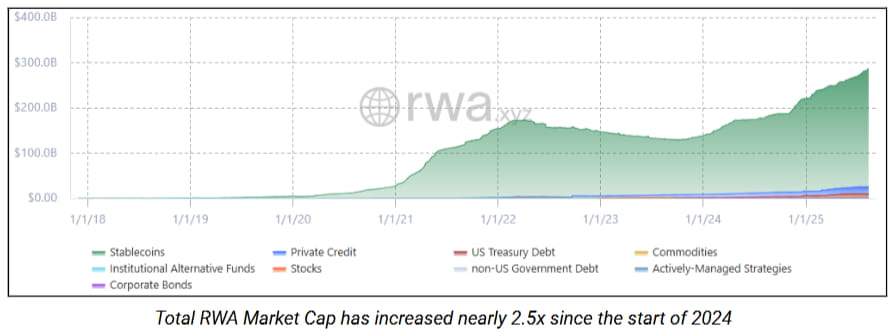
But how does tokenized U.S. treasury know the current interest rates? How does the on-chain gold token verify physical reserves? How does cross-chain asset transfer ensure security and compliance?
They all need Chainlink. The premise is having a trustworthy data and interoperability layer.
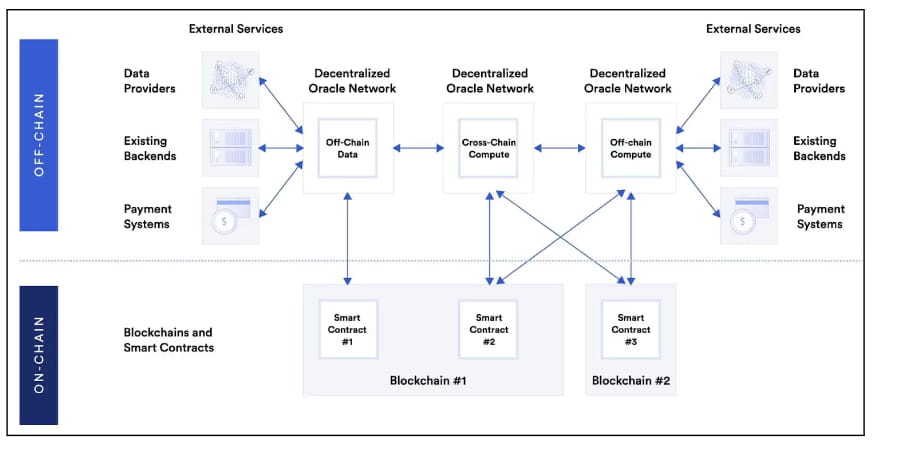
Business monopoly, but undervalued
Chainlink is truly a monopolist in its field:
$24 trillion+ in on-chain transaction value has been achieved through Chainlink.
$85 billion in total value protected (TVS)
Over $18 billion in total verified messages
50+ blockchain integrations, 500+ application integrations
No competitors can offer the combination of Chainlink's technical reliability, product breadth, compliance capabilities, and institutional trust. Once integrated, it becomes a critical infrastructure with high switching costs and self-reinforcing network effects.

In comparison, XRP's market cap is 15 times that of LINK, yet it has less than one-tenth of LINK's actual value.
Narrative reversal
For years, LINK has been burdened by the negative narrative of 'team dumping'. However, the LINK Reserve mechanism launched in August 2024 has brought about change.
Previously: Chainlink Labs funded operations through token sales, resulting in sustained selling pressure.
Now: Hundreds of millions of corporate revenue automatically converted to LINK purchases, creating sustained buying pressure.
With more collaboration expectations and additional institutions piloting production in the next 12-18 months, verifiable on-chain revenues will soar.
The market is still viewing LINK through an outdated lens, while the fundamentals have undergone a fundamental shift. This cognitive gap is the source of a tremendous investment opportunity.
Map of Chainlink deployments by global financial giants
The report also enumerates several key collaboration use cases, particularly with traditional financial giants.
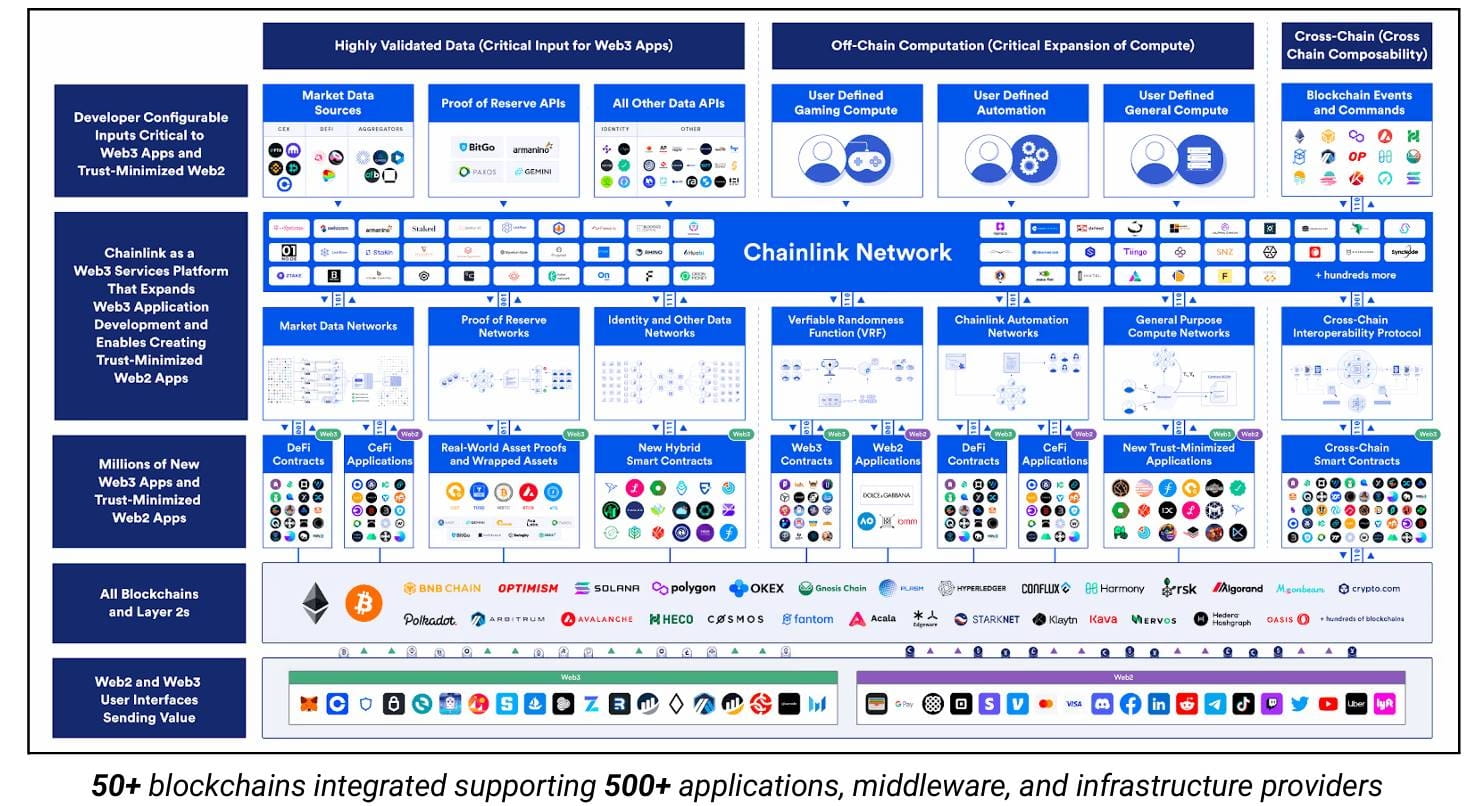
SWIFT: In November 2024, using Chainlink CCIP to trigger on-chain token operations for traditional SWIFT messages.
Participating institutions include: ANZ, BNP Paribas, BNY Mellon, Citigroup, Clearstream, Euroclear, Lloyds Bank, etc.; successfully simulated the transfer of tokenized assets between public and private chains.
JPMorgan Kinexys: In June 2025, JPMorgan's blockchain division Kinexys completed the first cross-chain delivery versus payment (DvP) settlement with Ondo Finance.
Chainlink's role: CRE (Corporate Runtime Environment) coordinates workflows, CCIP protocol ensures secure cross-chain messaging
White House recognition, technological and policy endorsement:
White House Crypto Summit, founder Sergey Nazarov invited to participate, engaging directly with the president and cabinet officials.
White House Digital Asset Report - Chainlink formally recognized as core infrastructure of the digital asset ecosystem.
Chainlink released detailed proposals for 10+ federal agency blockchain use cases.
Most importantly, these are not isolated experiments; each successful pilot represents a use case. These use cases all have Chainlink's shadow, even if it may not be in the spotlight.
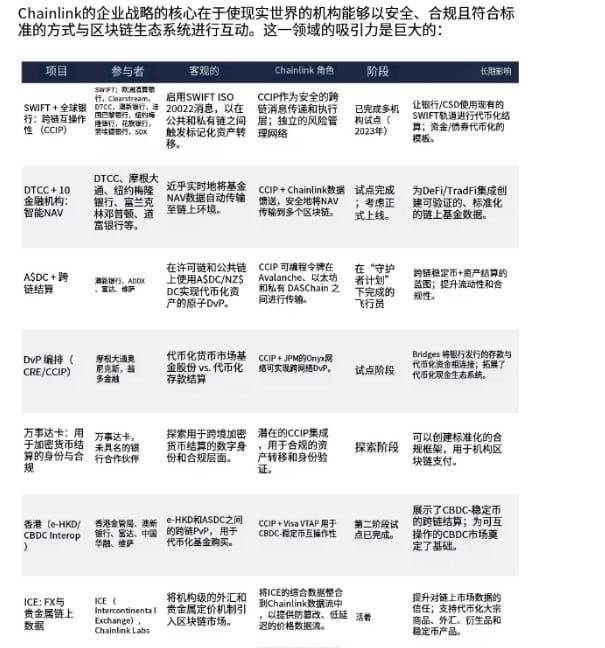
Not just an oracle, a monopoly position in middleware.
Many people's understanding of Chainlink still remains at the 'price oracle' stage. In reality, Chainlink has built a complete blockchain middleware ecosystem, becoming an indispensable bridge connecting blockchain and the real world.
Its products cover five key areas:
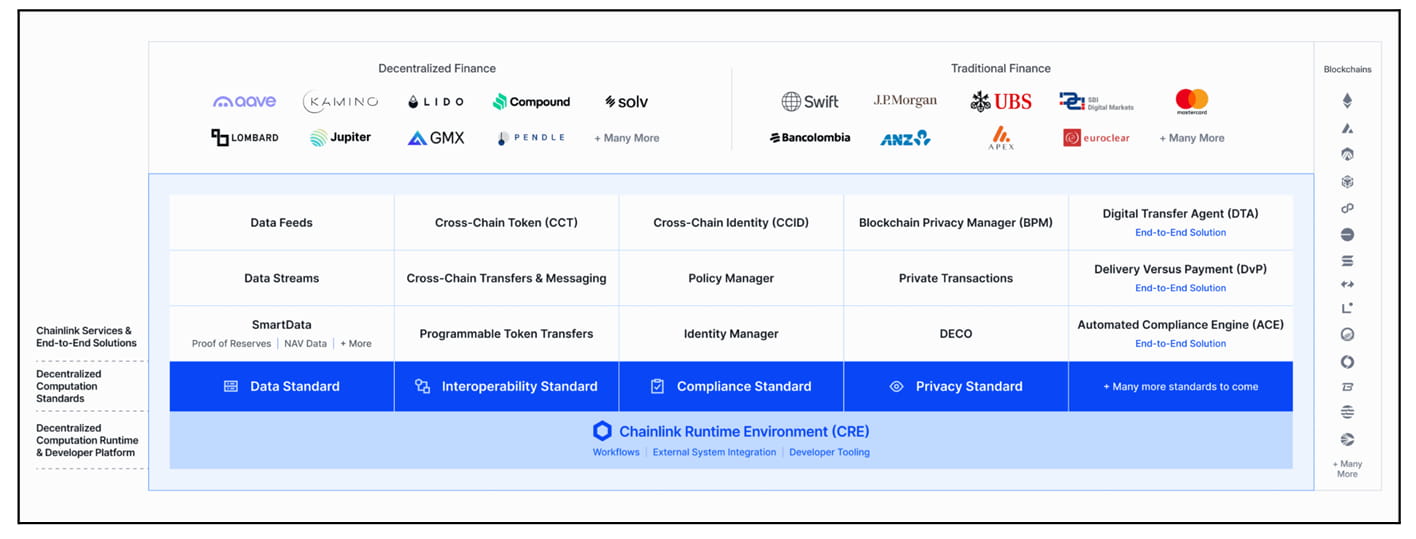
Data
Provides market data streams (e.g., price sources), proof of reserves, verifiable randomness, and ultra-low latency data streams.
These features ensure that blockchain applications can reliably access off-chain data, supporting various scenarios including finance, gaming, insurance, and more.
Compute
Provides off-chain computing capabilities (e.g., complex calculations via Functions) and event-driven automation features.
This enables blockchains to handle complex logic and computations without over-consuming on-chain resources.
Cross-Chain Interoperability
Provides CCIP (Cross-Chain Interoperability Protocol) supporting multi-network risk management.
CCIP enables secure transfer of assets and data between different blockchains, solving the cross-chain communication challenge.
Compliance
Provides an automated compliance engine (ACE) to programmatically execute compliance requirements according to legal rules.
This is particularly important for institutional users, helping them meet regulatory requirements.
Enterprise Integration Layer
Provides Chainlink Runtime Environment (CRE) for coordinating workflows between private and public chains.
CRE helps enterprises achieve seamless integration of blockchain with traditional systems, reducing friction and risk.
These are not standalone products but a symbiotic system. When SWIFT uses Chainlink, they are not just using an oracle but connecting to a complete infrastructure.
The competitive advantage here is that other market participants typically can only cover one or two areas, while Chainlink is the only solution that covers all key areas.
The benefit of using Chainlink for institutions is that it can be utilized as the sole integration point, significantly reducing integration friction and risk.
This full-stack capability, combined with years of accumulated security record and institutional trust, constitutes a technology moat that is nearly impossible to replicate.
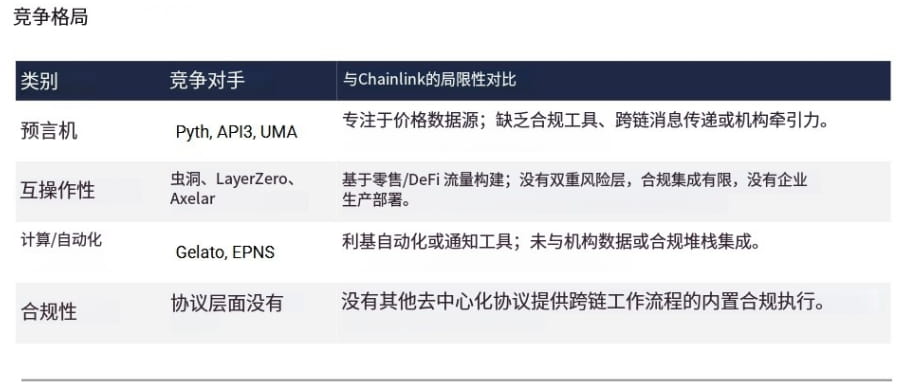
How should LINK be valued reasonably?
Now we come to the most critical question: How much is LINK actually worth?
The report employs several independent valuation methods, all pointing to similar conclusions.
Method 1: Comparison with XRP, relative valuation method
Taking XRP as an example, this 'bank coin' created in 2012 has yet to realize its promised use cases, with almost no real institutional adoption, yet it has a fully diluted market cap of $330 billion.
In contrast, Chainlink has been adopted by the world's top financial institutions, yet its market cap is only 1/15th that of XRP.
If we assume LINK is worth at least as much as XRP, then the current market cap of XRP is 15 times that of LINK, presenting an extremely attractive risk/return opportunity for investors.
When considering Chainlink's distinctly superior fundamentals, LINK's valuation is more appropriate for comparison with traditional financial companies (such as Visa and Mastercard) that have similar positioning in payment processing and data infrastructure.
By comparing with the market caps of these companies, LINK has a 20-30x upside potential.

Method 2: Traditional company logic, market share method
By 2030, approximately $19 trillion of real-world assets will be tokenized globally.
Chainlink, as the 'data pipeline' and 'cross-chain bridge' for these assets, is expected to capture 40% of the market share, serving approximately $7.6 trillion of tokenized assets.
These assets will enable Chainlink to process approximately $380 trillion in transaction volume annually. Based on a gradually increasing fee rate (currently 0.005% per transaction), Chainlink's annual revenue in 2030 will reach $82.4 billion.
$82.4 billion in annual revenue, at a 10x price-to-sales (PS) ratio, Chainlink's enterprise value is approximately $824 billion.
Assuming LINK's total supply remains around 1 billion, an $824 billion network value implies a theoretical value of about $824 per LINK. The current price is only around $22, indicating about 38 times potential upside.
Of course, this 38x is seen by the translator as a theoretical valuation, and any hypothetical change will significantly affect the outcome.
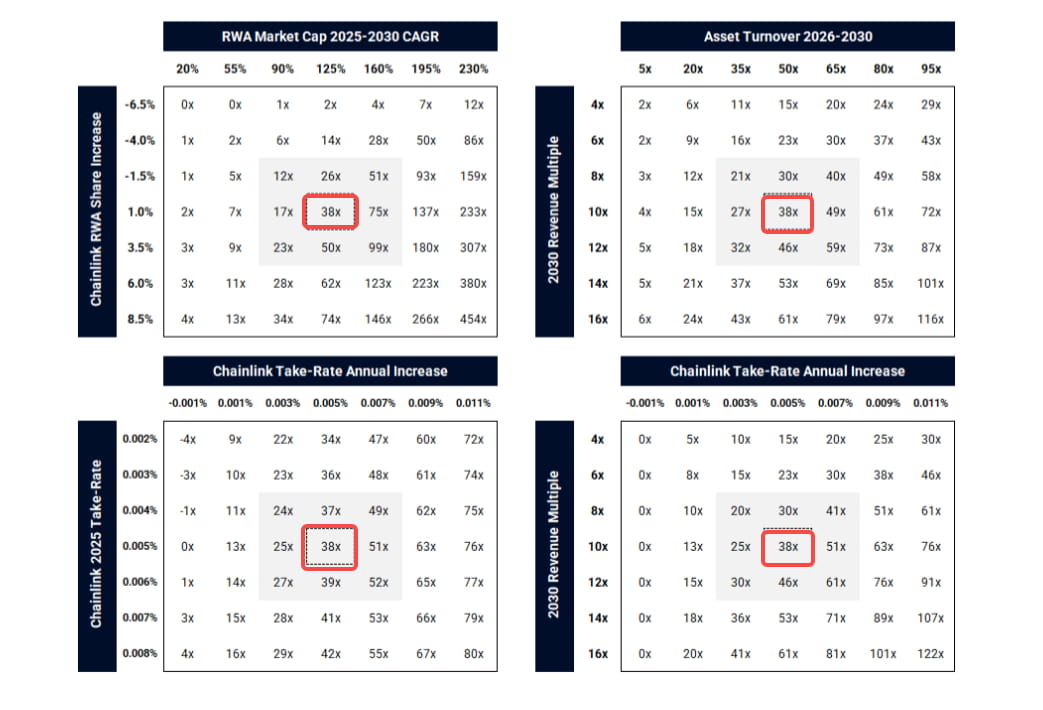
Recent catalysts (Q3/Q4)
LINK Reserve mechanism
For years, Chainlink has driven industry development through substantial subsidized services, but this has also obscured its profit potential, forcing Chainlink Labs to sustain operations through token sales. The newly launched LINK Reserve mechanism will fundamentally change this situation:
Flow of funds reversal, hundreds of millions of dollars in off-chain corporate revenue will be automatically used for market repurchases of LINK.
Market pressure conversion, shifting from sustained selling pressure to net buying pressure.
Confirmed Chainlink's enterprise-level profit potential.
Data service expansion
Data Streams cover traditional financial assets: officially supporting real-time pricing for US stocks and ETFs as of August 4, providing data support for tokenized funds, synthetic assets, and on-chain structured products.
ICE partnership: announced on August 11 the integration of comprehensive data streams for foreign exchange and precious metals from the Intercontinental Exchange, providing crucial support for institutional-grade on-chain pricing.
CCIP lands on Solana: In May, CCIP launched on the Solana mainnet, achieving cross-ecosystem settlement and messaging between EVM and SVM environments.
Product functionality upgrades: privacy and staking yields need to be focused on.
Privacy and permissioning features, including the launch of private transactions via CCIP; meeting confidentiality requirements for bank cross-chain transactions; Chainlink Privacy Manager, ensuring sensitive data does not leak to public chains.
Privacy security is also a prerequisite for banks to utilize Chainlink, transitioning from pilot to production.
Staking v0.2 and fee allocation are currently online, supporting more types of staking services.
After future upgrades, user fees will be directly rewarded to stakers; as data flows and CCIP transaction volumes grow, staking yields will significantly increase.
This is somewhat similar to the staking yields post-Ethereum merge, but based on actual enterprise-level revenue.
Conclusion
Chainlink offers one of the most asymmetric risk-return configurations in all financial markets.
No competitor can match Chainlink's advantages in integration breadth, technical reliability, regulatory compliance, and institutional trust. Highly anticipated pilot projects will expand into production environments in the next 12 to 18 months. Each integration deepens its moat through high switching costs, network effects, and entrenched compliance processes.
Financially, Chainlink provides diversified, recurring, and scalable revenue streams encompassing CCIP transaction fees, institutional data subscription services, proof of reserve certification, and automation services, creating a persistent growth engine directly related to the adoption of tokenized assets. With global tokenization projected to reach trillions of dollars, the market opportunity is vast and not yet effectively penetrated.
Despite these fundamental advantages, LINK remains a mispriced asset, with a valuation more akin to speculative projects rather than a monopoly financial infrastructure provider.
As the tokenized economy matures and Chainlink integrations shift to production environments, the market will be forced to significantly reassess LINK to reflect its systemic importance, revenue potential, and irreplaceable role in the global financial system.




